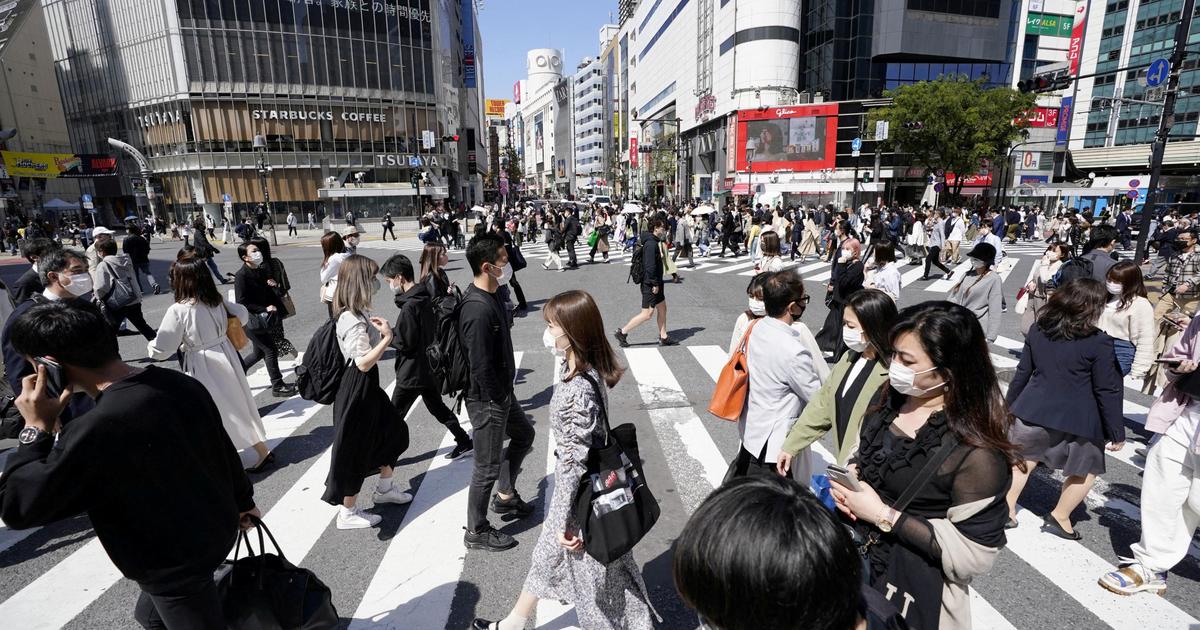By Kaitlin Sullivan -
NBC News
The death rate for the United States population age 15 and older skyrocketed in 2020 and particularly affected Hispanics and blacks, according to a report published Wednesday by the Centers for Disease Control and Prevention ( CDC).
The report reflects the definitive data from the registries of deaths during the first year of the pandemic and confirms that life expectancy in the country fell by almost two years, the largest drop in 12 months since World War II.
The age-adjusted death rate
increased nearly 17%, from 715.2 deaths per 100,000 people in 2019 to 835.4 deaths per 100,000 people in 2020.
"We don't normally see drops in life expectancy of this magnitude," said Bob Anderson, chief of the mortality statistics branch at the CDC's National Center for Health Statistics.
"Normally, when we see fluctuations in life expectancy, it is only during a couple of months of the year, so
this is quite significant,
" he said.
A woman contemplates the public art installation "In America: Remember," which remembers Americans killed by COVID-19. Getty Images file
Life expectancy went from 78.8 years in 2019 to 77 years in 2020: for men it fell 2.1 years, from 76.3 in 2019 to 74.2 in 2020;
while for women the average decrease was 1.5 years, from 81.4 in 2019 to 79.9 in 2020.
"Racial disparities", the most shocking
"One of the most shocking things about the report is the racial disparities," said Dr. Steven Woolf, director emeritus of the Virginia Commonwealth University Center for Society and Health.
[Symptoms of omicron: what is known about the infection causing the new variant]
Mortality in men of Latino origin shot up 43%, while in women it rose by 32%.
In the black community, it was up 28% and 25% for men and women respectively.
Among the white population, the data grew 13% and 12% respectively.
"This should not happen. There is this deep-seated health consequence of systemic racism," Woolf stressed.
COVID-19 first appeared as one of the top 10 causes of death in the United States
.
But the remaining 9 are the same as in 2019.
Heart disease was the leading cause of death, followed by cancer.
Diseases from the coronavirus ranked third, ahead of unintentional injuries such as overdoses, as well as strokes, chronic respiratory diseases, Alzheimer's, influenza and pneumonia, and kidney disease.
Israel begins applying a fourth dose of the COVID-19 vaccine to vulnerable sectors
Dec. 22, 202100: 28
Deaths associated with heart disease, unintentional injuries and diabetes recorded the largest increases.
"What these increases in causes unrelated to COVID-19 tell us is that, in addition to people dying directly from COVID-19,
there was also an adverse effect on people's health from conditions unrelated to the virus. "
said Woolf.
The decrease in access to care and medication, as well as the stress generated by the pandemic itself, contributed to the increase in deaths not related to the virus, he stressed.
Dr. Elizabeth Seaquist, director of the Division of Diabetes, Endocrinology and Metabolism at the University of Minnesota, agreed.
"During the pandemic,
many people have moved away from routine care
and have chosen not to go to clinics due to the risk of infection," he reflected.
In the absence of routine testing, warning signs of diseases such as heart disease and cancer can be missed.
Diabetes and the high price of insulin
Diabetic patients, who must follow strict control, are one of the most sensitive population groups.
"When their diabetes is not well controlled, they can die from acute problems," the expert recalled.
[COVID-19 tests in short supply amid spike in infections and year-end travel]
Deaths from diabetes multiplied by 16 from 2019 to 2020
, surpassing the 100,000 barrier for the first time, according to the report.
Access to insulin remained a barrier for many Americans last year.
In addition to missed medical appointments during the pandemic that could expire a prescription, the drug has also become unaffordable for many patients in recent years, Seaquist said.
"We are all going to end up getting the omicron variant," warns a health expert
Dec. 21, 202102: 11
The median price of insulin in the United States tripled from 2002 to 2013 and doubled from 2012 to 2016. In the past two years, states like Maine, Minnesota, and Texas have passed laws that limit the costs of insulin, although they may still be worth it. hundreds of dollars a month.
Despite the widespread increase in the death rate,
there was a substantial decline: infant mortality
.
Official data indicate that it fell by almost 3% in 2020, to a record low of 541.9 infant deaths per 100,000 live births.
[The US population grew at the lowest rate in its history during the first year of the pandemic: 0.1% in 12 months]
That decline, said Anderson of the NCHS, kept life expectancy in the United States from falling further.
"This is a positive point in the report," in Woolf's opinion.
"This tells us that this trend continued into 2020 despite the pandemic, which is of course good news."








